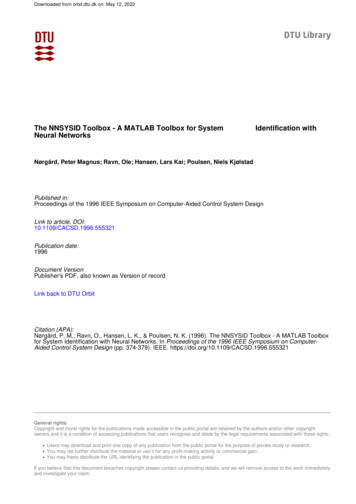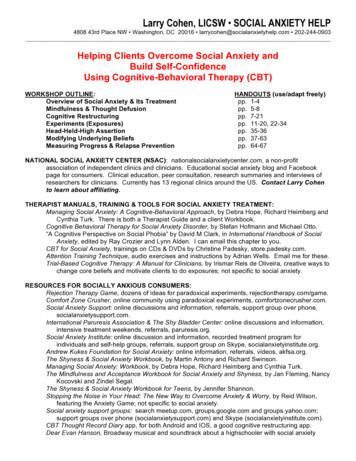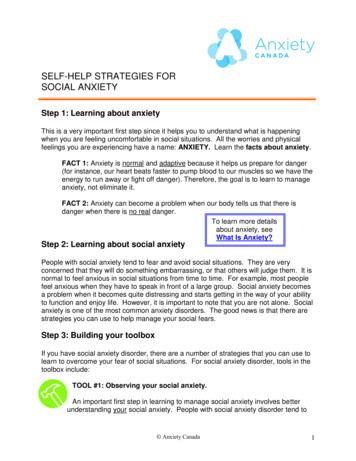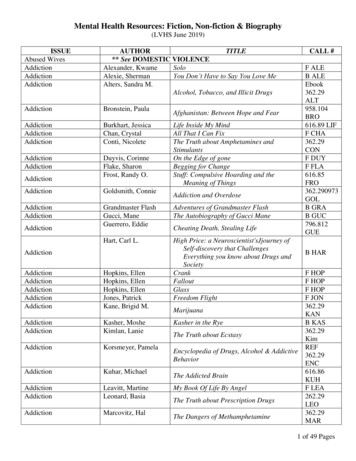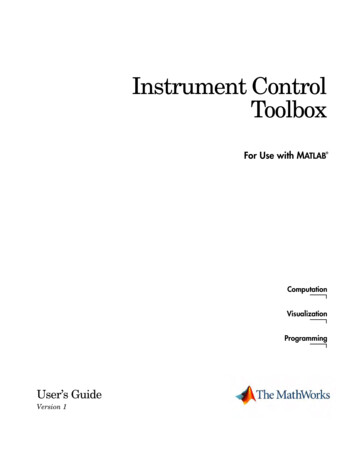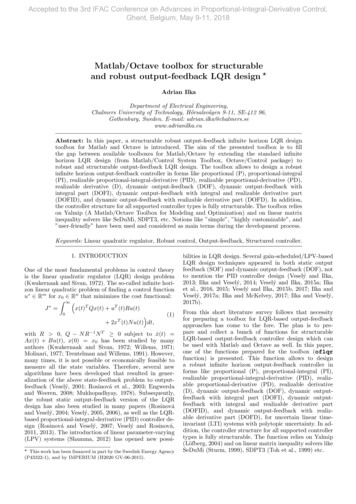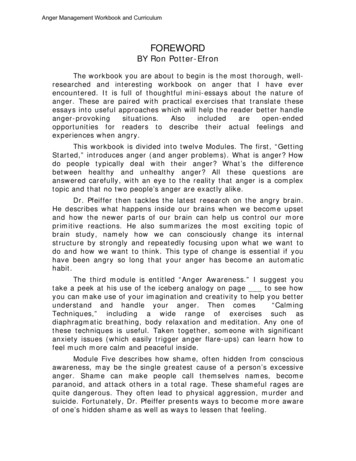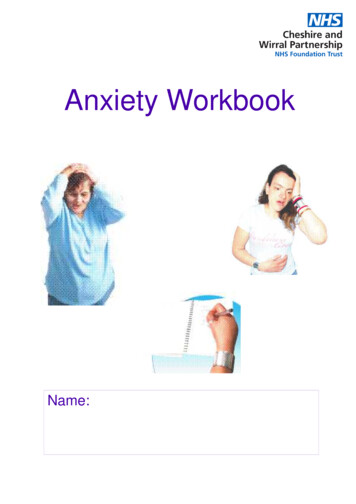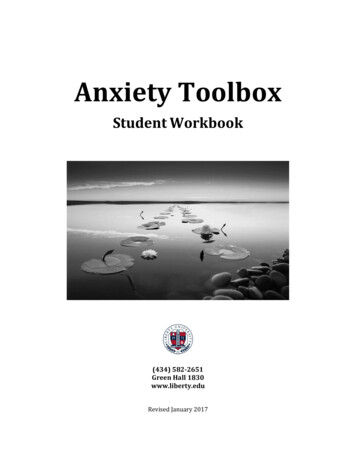
Transcription
Anxiety ToolboxStudent Workbook(434) 582-2651Green Hall 1830www.liberty.eduRevised January 2017
This Anxiety Toolbox workshop curriculum is based on the Anxiety Toolbox curriculum atCounseling Services of California Polytechnic State University, San Luis Obispo, with modificationsby the Broene Counseling Center of Calvin College. Used by permission.Table of ContentsWelcomeFrequently Asked QuestionsSession 1: Anxiety 101Stress versus Anxiety .Understanding Anxiety Disorders .Stress Curve .Anxiety-Avoidance Roller Coaster .Threat System (Fight or Flight) .Common Anxiety Symptoms .Feelings Wheel Cross Sectional Formulation (example) .Cross Sectional Formulation (blank) .Breathing Exercises .Sleep Hygiene .Homework Assignment .Cross Sectional Formulation (blank) .678891011121314151617Session 2: Automatic Thoughts & Unhelpful CognitionsCross Sectional Formulation (example) .Unhelpful Thinking Styles Identifying Triggers Worksheet Homework Assignment .Identifying Triggers Worksheet . .Cross Sectional Formulation (blank) .212223242527Session 3: Alternative Responses, Grounding, & Self-CareAlternative Response Worksheet (example) If You’re Having Trouble . .Alternative Response Worksheet (blank) .Grounding Exercises Pleasant Activities .My Plan for Managing Anxiety .313234373940Resources2
Welcome!Welcome to Anxiety Toolbox, a fast-paced, 3-session workshop intended to help increaseyour understanding and knowledge about anxiety. The goal is to provide you with someskills to recognize and manage symptoms you may be experiencing. We hope you find ithelpful.The goal of this workshop is to provide you with life-long tools you can use while facinganxiety-triggering situations. Remember, this intervention is not intended to “get rid of”your anxiety. While occasionally unpleasant, some anxiety can actually be a helpful andmotivating emotion. Our hope is that these three sessions provide you with a jumpingboard from which to integrate skills into your daily life in the service of reducing anxiety.By the end of this course, you will have received a lot of information, and at times it mayfeel overwhelming. Remember that like any skill (e.g., learning to ride a bike), the skills youwill learn in Anxiety Toolbox take time and practice to master. At times, you mayencounter obstacles and/or find it difficult to integrate these skills into your daily life.That’s okay – it’s how change works. And as with all change, it’s important to practice asmuch as you can, even after encountering setbacks.Think of your practice of these skills as a form of “mental health hygiene.” At the outset, itmay seem tedious and you may question why you need to practice these skills so often.Think of it like dental hygiene—you brush your teeth multiple times a day to prevent thebuildup of plaque and ultimately to prevent cavities. Similar to brushing your teeth, dailypractice prevents a buildup of anxiety and stress over time. The more you practice and usethese skills as part of your daily routine, the less tedious they may seem because theysimply become a regular part of daily life.A few guidelines to keep in mind This workshop is confidential. Do not share information about anyone in theworkshop with others, including others’ stories (even if you think no one will knowwhom you’re speaking about). We want to ensure that it feels safe to speak here.You are expected to attend all three sessions, as they build upon each other. If youmiss a session, you will be asked to switch to a different section of the workshop inorder to continue with the material in the proper order.Please be sure to let your workshop leader know (or call the counseling office)ahead of time if you are unable to attend a session.If at any time you feel that you need additional support, please let your workshopleader know or contact Student Counseling Services at 434-582-2651. You can alsofind additional resources online at www.liberty.edu/studentcounselingservices.We’re glad you’re here!3
Frequently Asked QuestionsWhat is Anxiety Toolbox?Anxiety Toolbox is a fast-paced, 3-session workshop specifically designed to help peoplewho struggle with a variety of anxiety-related concerns (e.g., panic attacks, GeneralizedAnxiety, test anxiety). The goal of this workshop is to provide education on anxiety and toteach coping skills for managing anxiety symptoms.Why does Anxiety Toolbox use a 3-session model?Teaching Anxiety Toolbox over the course of 3 sessions allows you sufficient time to learnthe concepts, with time to practice between sessions. Keeping it to three 50-minutesessions allows you to find time in your busy schedule to learn these skills.What if I need more than 3 weeks to learn the model?You are not alone. The skills taught in Anxiety Toolbox are difficult and take time to build.For this reason, we offer multiple other groups, workshops, and resources that areintended to provide further support for practicing these skills. For more information, talkwith your Anxiety Toolbox workshop leader or contact Student Counseling Services.What if I don’t feel comfortable in groups?Many people feel a little anxious about participating in a group. Anxiety Toolbox isstructured and curriculum-driven, like an academic class. You are not required to speak tothe entire group if you do not feel comfortable doing so. The facilitators respect eachparticipant’s right to share only what they are comfortable sharing and never require youto share sensitive or potentially embarrassing information about yourself.What if I have an urgent need to see a counselor during Anxiety Toolbox?Simply let the workshop leader or the Student Counseling Services front desk staff know,and they will facilitate you getting the support you need.Why do I have to do homework?The focus of this workshop is on building skills to cope with anxiety. In order to achievethat goal, regular practice is essential. The more you practice, the more you may find youget out of this workshop. The assignments are for you and only you, in the service of yourown personal growth. You will not be required to provide your responses at any timeduring this workshop. However, it’s important to bring your responses as you may beasked to look back on or elaborate on a prior assignment during the workshop.What if I didn’t do my homework?We encourage you to come to group regardless of whether or not you were able tocomplete the homework assignment. We can also assist you in working on examples whenthe homework is reviewed.4
SESSION ONEAnxiety 1015
Stress versus AnxietyEveryday Anxiety (Stress)Anxiety DisorderIn response to a known environmentalfactorIn response to an unknown source or inresponse to the experience of stressSymptoms go away when the stressorgoes awaySymptoms remain despite no identifiablestressorWorry about living away from home forthe first time, passing a class, a romanticbreakup, or other important life eventsConstant and unsubstantiated worry thatcauses significant distress and interfereswith your daily lifeEmbarrassment or self-consciousness inan uncomfortable or awkward socialsituation; feeling nervous about meetingnew peopleAvoidance of social situations due to fear ofbeing judged, embarrassed, or humiliatedFeeling nervous or sweating before a bigtest, class presentation, stageperformance, or other significant eventPanic attacks that seem out of the blue andpreoccupation with the fear of havinganother oneRealistic fear of a dangerous object, place,or situation (e.g. fear of poisonoussnakes)Irrational fear or avoidance of an object,place, or situation that poses little or nothreat of danger (e.g. fear of elevators)Making sure that you are healthy andliving in a safe environmentPerforming uncontrollable repetitiveactions, such as excessive cleaning, checking,touching or arrangingAdapted from: http://www.adaa.org/understanding-anxiety6
Understanding Anxiety DisordersWhile anxiety is a normal and adaptive experience for everyone, anxiety disorders arecharacterized by significant distress or impairment in social, academic/occupational, orother important areas of functioning (e.g., your general ability to function in life).Some of the most common anxiety disorders include:Generalized Anxiety Disorder:Chronic and unrealistic worry that feels difficult tocontrol about everyday things (i.e., things that donot worry most people)Social Anxiety Disorder:Chronic worry solely related to social situationsPanic Disorder:Characterized by episodes of “panic” that includethings like: adrenaline surge, fear of losing control,chest pain, racing heart, shortness of breath,dizzinessPhobias:Specific fears that are excessive in nature and oftenlead to avoiding that which is feared (e.g., publicspeaking, heights, tunnels, etc.)Obsessive-Compulsive Disorder:Excessive rumination (thinking) with repetitivebehaviors to reduce anxiety7
Yerkes Dodson Model of Stress Arousal & PerformanceAnxiety - Avoidance Roller CoasterAdapted from- anxiety8
9
Common Anxiety SymptomsPhysical SymptomsCognitive Symptoms Increased heart rate Shortness of breath Fear of losing control, beingunable to cope Chest pain or pressure Fear of physical injury or death Choking sensation Fear of “going crazy” Dizziness, lightheadedness Fear of negative evaluations byothers Sweating, hot flashes, chills Frightening thoughts, images, ormemories Nausea, upset stomach,diarrhea Trembling, shaking Perceptions of unreality ordetachment Weakness, unsteadiness,faintness Poor concentration, confusion,distractibility Tense muscles, rigidity Dry mouth Narrowing of attention,hypervigilance for threat Other: Poor memory Difficulty in reasoning, loss ofobjectivityBehavioral Symptoms Other: Avoidance of threat cues orsituationsEmotional Symptoms Escape, flight Feeling nervous, tense, woundup Pursuit of safety, reassurance Restlessness, agitation, pacing Feeling frightened, fearful,terrified Hyperventilation Freezing, motionlessness Being edgy, jumpy, jittery Difficulty speaking Being impatient, frustrated Other: Other:Adapted from The Anxiety and Worry Workbook by Clark and Beck10
Feelings Wheel11
Cross Sectional Formulation (example entry)Situation (When? Where? What? With whom? What did you feel anxious about?)A student invited me to a party in my residence hall, but I didn’t knowher very well and felt anxious about going.Physical (When anxious, what physicalsensations did you experience? What did younotice in your body?)Heart racing, tight chest,shallow breathing, hotEmotional (What emotionsCognitive (What wentcame up for you when you feltanxious?)through your mind when youfelt anxious? What did that sayor mean about you or thesituation?)Scared, ashamed,Lonely, agitated,nervousI won’t know anyone atthe party and will feelawkward. No one willlike me because I’m sosocially awkward. Iwon’t have fun. But ifI say no, this personwon’t like me and Iwouldn’t make friends.Behavioral (What was your first instinctand/or automatic response? What did youdo and/or avoid doing at the time?)My first instinct was to say no.I avoided saying no but tellingher that I would think about it.I never got back to her. Ididn’t go to the party.12
Cross Sectional FormulationSituation (When? Where? What? With whom? What did you feel anxious about?)Physical (When anxious, what physicalsensations did you experience? What did younotice in your body?)Emotional (What emotionsCognitive (What wentcame up for you when you feltanxious?)through your mind when youfelt anxious? What did that sayor mean about you or thesituation?)Behavioral (What was your first instinctand/or automatic response? What did youdo and/or avoid doing at the time?)13
Breathing ExercisesBelly (or Diaphragmatic) BreathingYou can do this exercise in any position, but it is helpful to do this exercise while lyingdown when first learning belly breathing.1. Lie comfortably on your back, with a pillow under your head, your knees bent and yourback flat. You can stretch your legs out if that's more comfortable.2. Place one hand on your belly and one hand on your upper chest.3. Inhale slowly and expand your belly as you breathe so that your lower hand moves withyour belly. The hand on your chest should remain as still as possible.4. Slowly exhale, focusing on the movement of your belly and lower hand as it returns toits original position.5. Repeat steps 3 & 4 for several minutes, always focusing on the movement of the belly asyou breathe. If your mind wanders, gently bring your attention back to your breathing.Breath-Counting ExerciseThis exercise focuses on the use of counting with the rhythm of the breath. Start with ashort period of time and gradually increase the time. Set a timer so that you do not have toworry about when to stop.1. Find a comfortable position. Take several deep breaths and settle into yourself. Youmay either close your eyes or keep them open, depending on your own comfort. If youkeep them open, fix them on an object or a spot on the floor about four feet in front ofyou. Your eyes may be either focused or unfocused.2. Take deep, comfortable breaths. Notice your inhalation. The pause between inhalingand exhaling, your exhalation, and the pause before starting again.3. As you inhale, count, “one.” As you exhale, count, “two.” Inhale, “three.” Exhale,“four.” Continue until you reach 10 then start over.4. If you lose count, simply begin with “one” on your next inhalation.5. If you notice your mind has wandered, gently notice this, and return your focus back tocounting your breath.6. If you notice any body sensations catching your attention, focus on that sensation untilit fades. Then return your attention back to counting your breaths.14
Sleep HygieneWhat is Sleep Hygiene? ‘Sleep hygiene’ is the term used to describe good sleephabits. Considerable research has gone into developing a set of guidelines and tipswhich are designed to enhance good sleeping, and there is much evidence to suggestthat these strategies can provide long-term solutions to sleep difficulties.1. Get regular. Go tobed and get up atmore or less the sametime every day, evenon weekends and days off!2. Get up & try again. Go to sleep onlywhen tired. If you haven’t been able tofall asleep after 30 minutes, get up anddo something calming (not stimulating)until you feel sleepy, then return to bedand try again.3. Avoid caffeine & nicotine. Avoidconsuming any caffeine(coffee, tea, soda, chocolate) ornicotine (cigarettes) for atleast 4-6 hours before going tobed. These act as stimulantsand interfere with falling asleep4. Avoid alcohol. Avoid alcohol for atleast 4-6 hours before bed because itinterrupts the quality of sleep.5. Bed is for sleeping. Do not t to useyour bed for anything other thansleeping and sex, so that your bodycomes to associate bed with sleep.7. The right space. Make your bed andbedroom quiet and comfortable forsleeping. An eye mask and earplugsmay help block out light and noise.8. No naps. Avoid taking naps during theday. If you can’t make it through theday without a nap, make sure it is forless than an hour and before 3pm.9. Sleep rituals. Develop rituals toremind your bodythat it is time tosleep, like relaxingstretches orbreathing exercisesfor 15 minutes before bed.10. No clock-watching. Checking the clockduring the night can wake you up andreinforces negative thoughts such as“Oh no, look how late it is, I’ll never getto sleep.”11. Keep daytime routine the same.Even if you have a bad night sleep it isimportant that you try to keep yourdaytime activities the same as you hadplanned. That is, don’t avoid activitiesbecause you feel tired. This canreinforce the insomnia.6. Electronics Curfew.Don’t use back-litelectronics 60 minutesprior to bed, as theartificial light prevents hormones andneurons that promote sleep.Adapted from http://www.cci.health.wa.gov.au15
Session 1: Homework AssignmentHomework 1Complete at least 1 simple Cross-Sectional Formulation worksheet for review next week. multiple blank copies provided starting on page 14Homework 2Practice Deep Breathing. place one hand on stomach and one on chest – as you breathe, imagine using theair you breathe in to push against the hand on your stomach take a deep breath in through the nose, counting as you inhale: 1 2 3 4 hold for a count of 2 exhale through the mouth, as if you are blowing out a candle, counting as youexhale: 1 2 3 4 pause and repeatHomework 3Implement 1 sleep hygiene tip. see page 1216
Cross Sectional FormulationSituation (When? Where? What? With whom? What did you feel anxious about?)Physical (When anxious, what physicalsensations did you experience? What did younotice in your body?)Emotional (What emotionsCognitive (What wentcame up for you when you feltanxious?)through your mind when youfelt anxious? What did that sayor mean about you or thesituation?)Behavioral (What was your first instinctand/or automatic response? What did youdo and/or avoid doing at the time?)17
Cross Sectional FormulationSituation (When? Where? What? With whom? What did you feel anxious about?)Physical (When anxious, what physicalsensations did you experience? What did younotice in your body?)Emotional (What emotionsCognitive (What wentcame up for you when you feltanxious?)through your mind when youfelt anxious? What did that sayor mean about you or thesituation?)Behavioral (What was your first instinctand/or automatic response? What did youdo and/or avoid doing at the time?)18
Cross Sectional FormulationSituation (When? Where? What? With whom? What did you feel anxious about?)Physical (When anxious, what physicalsensations did you experience? What did younotice in your body?)Emotional (What emotionsCognitive (What wentcame up for you when you feltanxious?)through your mind when youfelt anxious? What did that sayor mean about you or thesituation?)Behavioral (What was your first instinctand/or automatic response? What did youdo and/or avoid doing at the time?)19
SESSION TWOAutomatic Thoughts&Unhelpful Cognitions20
Cross Sectional Formulation (example)Situation (When? Where? What? With whom? What did you feel anxious about?)A student invited me to a party in my residence hall, but I didn’tknow her very well and felt anxious about going.Physical (When anxious, what physicalsensations did you experience? What did younotice in your body?)Heart racing, tight chest,shallow breathing, hotCognitive (What wentEmotional (What emotionsthrough your mind when youfelt anxious? What did that sayor mean about you or thesituation?)came up for you when you feltanxious?)Scared, ashamed,Lonely, agitated,nervousI won’t know anyone atthe party and will feelawkward. No one willlike me because I’m sosocially awkward. Iwon’t have fun. But ifI say no, this personwon’t like me and Iwouldn’t make friends.Behavioral (What was your first instinctand/or automatic response? What did youdo and/or avoid doing at the time?)My first instinct was to say no.I avoided saying no but tellingher that I would think about it.I never got back to her. Ididn’t go to the party.21
22
Identifying Triggers Worksheet (In-session)While at times it may be difficult to identify a trigger, understanding your triggers foranxiety is an important step in helping you know when to implement and/or emphasizepractice of the coping strategies you will learn in Anxiety Toolbox. Triggers can be externalevents (e.g., a test) or internal stimuli (e.g., a physical sensation or emotion) that led to yourexperience of anxiety (i.e., the emotional, physical, cognitive, and behavioral symptomspreviously discussed during this workshop). Remember that sometimes the symptomsthemselves can be a trigger that starts the cycle of anxiety.The following are some typical categories in which triggers might appear with examples:Responses to Internal Stimuli: Emotions: e.g., feeling down, fear or worry Mental Images: e.g., replaying interpersonal interactions or performance experience Physical State: e.g., racing heartbeat, lightheadedness, tightness in chest Thoughts: e.g., “I might fail this test”, “That person must not like me”, “If someone talksto me in class, I won’t be able to handle it.”Responses to External Stimuli: Presence of Others: e.g., attending a social event, meeting with a professor, spendingtime with roommates, family interactions Physical Setting: e.g., a classroom, open areas on campus, inside a car Social Pressure: e.g., feeling pressured to make friends, feeling pressured to performwell in school (in comparison to your peers) Activities: e.g., a sports event, a party, going home for the weekendList some triggers you experience related to your anxiety:1.2.3.4.5.23
Session 2: Homework AssignmentHomework 1Complete Identifying Triggers Worksheet on pages 22-23.Homework 2Complete at least 1 simple Cross Sectional Formulation worksheet for review next week. multiple blank copies provided starting on page 2424
Identifying Triggers Worksheet (Homework)Pay attention to any triggers for anxiety that you may experience over the next week.Write them down in the following categories. You may have triggers in all of the categoriesor you may notice triggers in only one or two categories. (Use the “other” category fortriggers you feel don’t fit in the options listed.)Emotions:1.2.3.Mental Images:1.2.3.Physical States:1.2.3.Thoughts:1.2.3.25
Presence of Others:1.2.3.Physical Setting:1.2.3.Social Pressure:1.2.3.Activities:1.2.3.Other:1.2.3.26
Cross Sectional FormulationSituation (When? Where? What? With whom? What did you feel anxious about?)Physical (When anxious, what physicalsensations did you experience? What did younotice in your body?)Cognitive (What wentEmotional (What emotionsthrough your mind when youfelt anxious? What did that sayor mean about you or thesituation?)came up for you when you feltanxious?)Behavioral (What was your first instinctand/or automatic response? What did youdo and/or avoid doing at the time?)27
Cross Sectional FormulationSituation (When? Where? What? With whom? What did you feel anxious about?)Physical (When anxious, what physicalsensations did you experience? What did younotice in your body?)Emotional (What emotionsCognitive (What wentcame up for you when you feltanxious?)through your mind when youfelt anxious? What did that sayor mean about you or thesituation?)Behavioral (What was your first instinctand/or automatic response? What did youdo and/or avoid doing at the time?)28
Cross Sectional FormulationSituation (When? Where? What? With whom? What did you feel anxious about?)Physical (When anxious, what physicalsensations did you experience? What did younotice in your body?)Cognitive (What went throughEmotional (What emotionsyour mind when you felt anxious?What did that say or mean aboutyou or the situation?)came up for you when you feltanxious?)Behavioral (What was your first instinctand/or automatic response? What did youdo and/or avoid doing at the time?)29
SESSION THREEAlternative Responses,Grounding, & Self-Care:Putting It AllTogether30
Alternative Response Worksheet (example)Situation: (When? Where? What? With whom? What did you feel anxiousabout?)A student invited me to a party in my residence hall, but Ididn’t know her very well and felt anxious about going.Alternative Thoughtsand Images: (Are thesethoughts helpful? Arethe anxious thoughts100% true/accurate,100% of the time? Whatare other ways oflooking at this? What isthe bigger picture? )I may not be associally awkward asI think.If she invited me,she probably wantsme there.I might still havean okay time, evenif I am anxious.Alternative Behaviors:(What could you do thatwould be more helpfulfor you, others, &/or thesituation? What arecoping strategies thatmight be helpful?)Coping Strategies ICan Use: Deep breathing Distract myselfAlternative Feelings:(What are feelings thatare more helpful? Whatif you acted and thoughtdifferently about thesituation? How mightthese changes help youfeel differently?)ExcitedWantedLiked Seek support from Hopefula friend/ familymember Do a pleasurableactivity Use alternative responseworksheetOriginal Outcome: (What was the original outcome?)I stayed in my room and watched Netflix.Desired Outcome: (Using these new alternatives, what would you like theoutcome to be in the future?)I want to go to the party so that I can make friends. If I feeltoo uncomfortable, I can always leave.31
If you're having trouble, ask yourself these questions:Whenever we recognize an anxiety-related thought, feeling or behavior, it can be veryhelpful to ask ourselves the following questions:Alternative THOUGHTS:1.2.3.4.5.What are other ways of looking at this situation?Am I looking at the whole picture?What might be a more helpful way of picturing this situation?What unhelpful thinking styles might I be using here (see below)?What is the evidence that my thoughts are true? Is there an alternative way of thinkingabout this situation that is more true?6. What is the probability that my thoughts will happen? What are some other things thatcould happen that are equally, if not more, probable?7. Have I had any experiences in the past that suggests that this thought might not beCOMPLETELY true ALL of the time?8. Can I really predict the future? Is it helpful to try? What is more helpful?9. Am I exaggerating how bad the result might be? What is more realistic?10. Can I read people’s minds? What else might they be thinking (that’s not so negative)?11. If a friend or loved one were in this situation and had this thought, what would I tellthem?Common Cognitive Distortions (Unhelpful Thinking Styles)All or Nothing Thinking: thinking in Over-generalizing: seeing a pattern based uponabsolute, black and white categoriesa single event or being overly broad inconclusions we drawMental Filter: only paying attentionDisqualifying the positive: discounting theto certain types of evidence (e.g.,good things that have happeneddwelling on the negatives)Jumping to Conclusions:Magnification (catastrophizing) andMind reading: imagining we knowminimization: blowing things out of proportionwhat others are thinkingor inappropriately shrinking something to makeFortune telling: predicting the future it seem less importantEmotional Reasoning: assumingShould/Must Thinking: Using words likebecause we feel a certain way, what“should”, “must”, “ought to” or “have to”we think must be trueLabeling: assigning labels toPersonalization: blaming yourself forourselves or otherssomething you weren’t entirely responsible forOR blaming others and overlooking ways youmay have contributed to the outcome32
Alternative BEHAVIORS:1. What could I do in the moment that would be more helpful?2. What’s the best thing to do (for me, for others, or for the situation)?3. If my feared situation happens, how will I cope? What coping skills can I use to handlemy feared situation? What have I done in the past that was successful?4. Am I needing to work on acceptance, letting go of control, being okay with less thanperfect, or having faith in the future and myself?5. Breathe: Focus your attention on your breathing. Imagine you have a balloon in yourbelly, inflating on the in-breath, deflating on the out-breath.Alternative FEELINGS:1. What might it feel like if I acted/thought differently?2. When I’m not feeling this way, do I think about this situation differently?3. Are there any strengths or positives in me or the situation that I might be ignoring?4. What else might this anxiety be related to? Is it really about feeling ?5. Tell yourself: “This feeling will pass. It’s a normal body reaction.”33
Alternative Response WorksheetSituation (When? Where? What? With whom? What did you feel anxious about?)Alternative Thoughts andImages: (Are thesethoughts helpful? Are theanxious thoughts 100%true/accurate, 100% of thetime? What are other waysof looking at this? What isthe bigger picture? )Alternative Behaviors:(What could you do thatwould be more helpful foryou, others, &/or thesituation? What are copingstrategies that might behelpful?)Coping Strategies I CanUse: Deep breathingAlternative Feelings:(What are feelings that aremore helpful? What if youacted and thoughtdifferently about thesituation? How might thesechanges help you feeldifferently?) Distract myself Seek support from afriend/ familymember Do a pleasurableactivity Use alternativeresponse worksheet Original Outcome: (What was the original outcome?)Desired Outcome: (Using these new alternatives, what would you like the outcome to be inthe future?)34
Alternative Response WorksheetSituation (When? Where? What? With whom? What did you feel anxious about?)Alternative Thoughts andImages: (Are thesethoughts helpful? Are theanxious thoughts 100%true/accurate, 100% of thetime? What are other waysof looking at this? What isthe bigger picture? )Alternative Behaviors:(What could you do thatwould be more helpful foryou, others, &/or thesituation? What are copingstrategies that might behelpful?)Coping Strategies I CanUse: Deep breathingAlternative Feelings:(What are feelings that aremore helpful? What if youacted and thoughtdifferently about thesituation? How might thesechanges help you feeldifferently?) Distract myself Seek support from afriend/ familymember Do a pleasurableactivity Use alternativeresponse worksheet Original Outcome: (What w
Anxiety Toolbox Student Workbook (434)582-2651Green Hall 1
